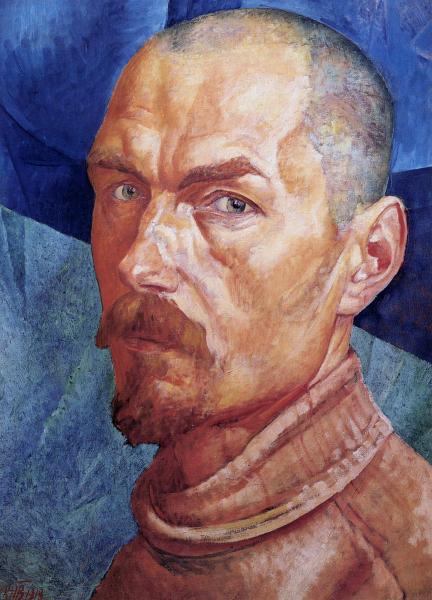Artist – Petrov -Vodkin

1918 was in the work of Petrov-Vodkin the year of still life. His letters to the mother of that time, full of reports on increasing the prices of bread and firewood, are the annals of the destruction of the usual life structure. Apparently, close attention to the subject world was an attempt to fix its uncontrollably blurry contours, the resistance of total dematerialization. Self -portrait is an example of one of the few appeals to another genre is the result of intense reflection on the role of the artist in apocalyptic times, the search for stability in the depths of his own personality. January 30, 1918 Petrov-Vodkin was chosen as a professor at the Academy of Arts. “No matter how honorable or flattering, but with great hesitation I take this big task. And if it were not for the difficult time for the Motherland and the danger that art would wander among universal destruction, I have no right to abandon at least an attempt to improve our higher school … ”Responsibility was associated with the awareness of the opening opportunities of building a new art building based on its own artistic and worldview principles. This position of the guardian demiurge dictated the icon formula for self-portrait. In accordance with the concept of a new, “planetary” vision put forward by the artist, his strict face arises at the intersection of “planetary” measurements of the sky and firmament, forming the figure of the cross. (L. B.).
Russian portrait. XX century: St. Petersburg, 2001. WITH. 159.
In the self -portrait of 1918, enchantment, spellbound involvement in other worlds, the unhealthy laws of being, still inherent in many characters of the artist, disappeared. In the almost sculptural modeling of the relief of the head, in the chipping of facial features, in the firmness and clarity of the view, the artist extremely accurately expressed the main pathos of his life of that time – the acceptance of reality without deceiving idealization of it, acceptance of courageous and sober, with the consciousness of the inevitability of self -sacrifice and readiness for it. At the same time, the psychological space of the portrait is not limited by the momentary of the real environment, it includes the whole expiration of the green-blue spheres of the universe, the spirit, history … The planetary principle underlying this work is amazingly combined with the concept of the portrait of the quatrocento era: a person in the center of the universe, elevated over the world, heroic and at the same time tragically lonely.
Petrov-Vodkin Kuzma Sergeevich (1878–1939)-painter, graphic, theorist, writer. Honored Artist of the RSFSR (1930).
Born in Khvalynsk Saratov province. He studied at an icon -painting workshop, later – in classes of painting and drawing f.E. Burova in Samara (1893–1895), at the Central School of Technical Drawing Baron A.L. Stieglitsa in St. Petersburg (1895–1897), at the Moscow School of Painting, Sculpture and Architecture at A.E. Arkhipova, n.A. Kasatkina and c.A. Serova (1897–1904), in studio A. Ashbe (1901) in Munich, in private academies of Paris (1905–1908), including in studio f. Kolarossi. In the same years he visited Italy, Greece, France, North Africa. Since 1908 exhibition participant "Golden rune". Member of the Societies "World of Art" (1910–1922), "Four arts" (1925–1928) and others. Taught at school E.N. Zvantseva (1910–1915) in St. Petersburg, in free art workshops (1918–1921), the All -Russian Academy of Arts (1918–1933). Professor. First Chairman of the Leningrad Branch of the Union of Soviet Artists. Author of genre compositions, portraits and still lifes. Passed through the hobby symbolism, post -impressionism (art p. Gauguin and a. Matisse). In his work was based on the heritage of Ancient Rus’.